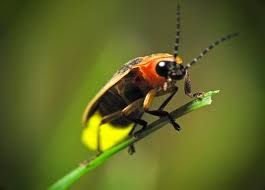Firefly Walk at Knox Farm State Park on June 15 from 9pm to 10:30pm. Led by NY State Parks Naturalist. FREE but register at 549-1050.
(Plunkettts.net) The process by which fireflies create light is called “bioluminescence”. Fireflies control bioluminescence through a fairly complex chemical reaction inside their bodies. First, they process food and break it down into the chemicals required to start the process, which include calcium and the energy transporter Adenosine triphosphate (ATP). These chemicals react with a compound fireflies naturally synthesize in the cells of their abdomens, called luciferin, to create an enzyme called luciferase.
Luciferase combines with oxygen and ATP to generate light. When oxygen enters the firefly’s light-producing organ, it combines with the other chemicals in the organ rapidly, creating excess energy that’s disposed of in the form of light. Fireflies are capable of regulating when they allow oxygen to enter their light organs by “opening up” or closing the organ at will. When the organ is open, oxygen enters and the firefly glows. When they close the organ, oxygen can’t combine with luciferase, and the lights go out. Different species of firefly may even glow in different colors, including the traditional yellow, light blue, or even faint red.





